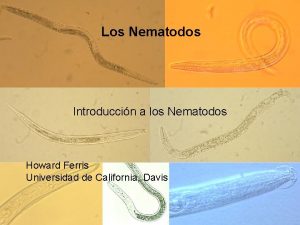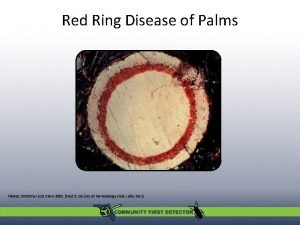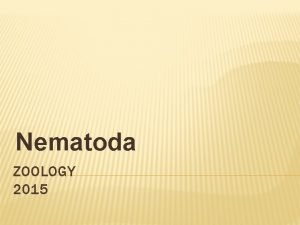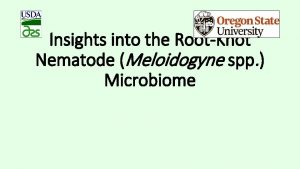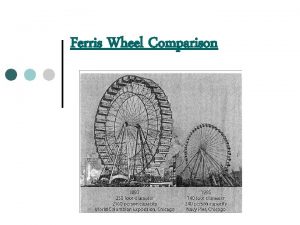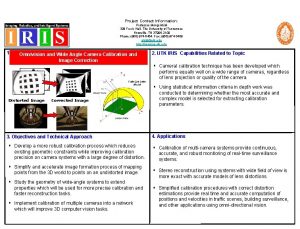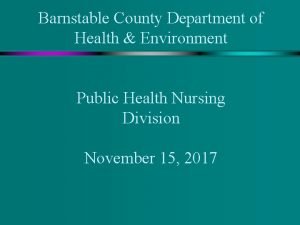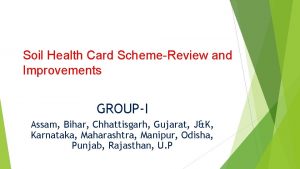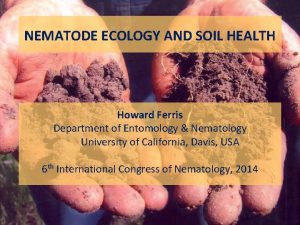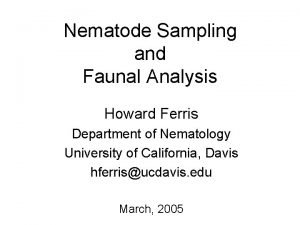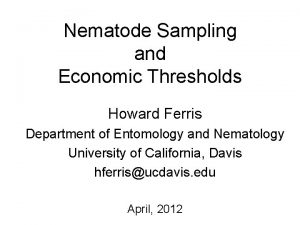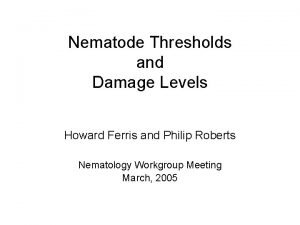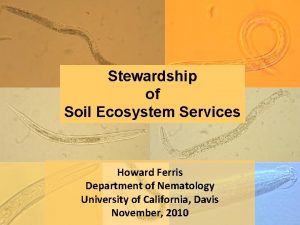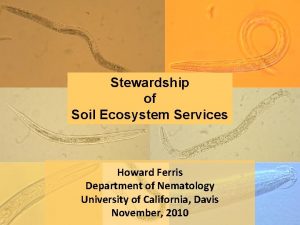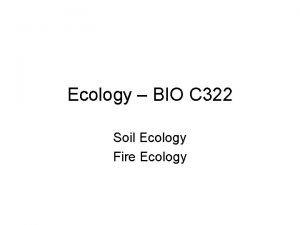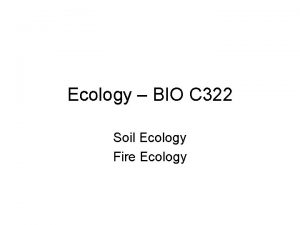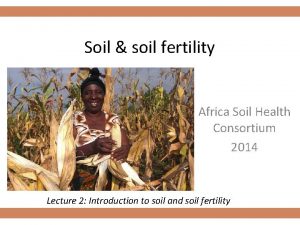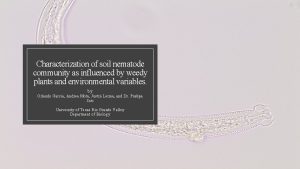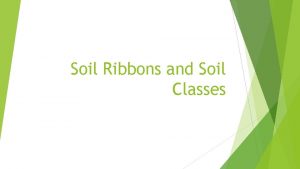NEMATODE ECOLOGY AND SOIL HEALTH Howard Ferris Department


































- Slides: 34

NEMATODE ECOLOGY AND SOIL HEALTH Howard Ferris Department of Entomology & Nematology University of California, Davis, USA México, 2014

Soil Health The ability of a soil to perform its ecosystem functions within the constraints of its environment Major Functions: Sustain plant and animal productivity and diversity Maintain or enhance water and air quality Support human health and habitation --++ Physical Biological • a subjective assessment of physical, chemical and biological components • I will focus on the biological component while recognizing that all are interconnected Physical Chemical • the approaches discussed could be applied to any assemblage of soil organisms +++++++ • I will use the nematode assemblage as bioindicator due to its functional diversity and species richness Foci during the evolution of conventional agriculture +, -

Ecosystem Functions - metabolic and behavioral activities of organisms that impact the biotic or abiotic components of the ecosystem Feeding: Behavior: Ingestion, assimilation, defecation and excretion Movement, activity, migration Functions may be classified, subjectively, as Services, Disservices (or Neutral) Disservices: Damage plants of agricultural or ornamental significance Injure humans and vertebrate animals Services: Sequester and redistribute minerals Mineralize organic molecules Accelerate turnover Regulate and suppress pests Alter substrate to provide access to other organisms Redistribute organisms in space Biodegrade toxins Reduce soil erosion Increase agricultural production

The Latitude of Health Paul Sorauer introduced the concept of Latitude of Health (Sorauer, P. 1908. Handbuch der Pflanzenkrankheiten) Let us consider the soil as a living organism. Then, paraphrasing and adapting Sorauer: Each ecosystem function oscillates between minima and maxima. The point at which the degree of functioning is greatest is its optimum. The field of oscillation of the functions about their optima, within the limits of their minima may be considered the “latitude of health" of the system. 1 ecosystem 2 functions 3 unhealthy latitude of health latitude of life zone of optimum health Many conventionally-managed agricultural soils are outside the latitude of health and some may be outside the latitude of life.

Nematodes as Bioindicators § Abundance; diversity of form and function; distribution § Direct contact with their aquatic microenvironment § Relatively permanent residents; assessments not complicated by influx or efflux § Occupy key positions in soil food webs, both as predators and prey § Standardized sampling, extraction and assessment procedures § Readily identified by both microscopic and molecular methods § Clear relationship between structure and function § High intrinsic information value per sample regarding resource-flow channels, nutrient status, soil contaminants, environmental stress Bongers and Ferris, 1999

Nematodes as Bioindicators Three components of the assessment of the biological component of soil health are: 1. Faunal Analysis - habitat quality and available ecosystem services 2. Metabolic Footprints - the magnitude of the ecosystem services 3. Diversity of Functional Classes - the complementarity and successional potential of ecosystem functions and services

1 opportunism 2 3 enrichment 4 5 structure stability Life Habit Series (colonizer-persister) Structure Indicators Basal Fauna Enrichment Indicators Bongers Life course duration Growth rates Response to resources Sensitivity to disturbance 1. Nematode Faunal Analysis

Hypotheses of Food Web Structure and Function Ba 1 Enriched • Maturing • N-enriched • Low C: N • Bacterial • Regulated En ric hm en t in de x • Disturbed • N-enriched • Low C: N • Bacterial • Conducive Structured Fu 2 Basal condition Ba 2 • Degraded • Depleted • High C: N • Fungal Basal • Conducive Ca 3 Fu 3 Ba 3 Om 4 Ca 4 Fu 4 Ba 4 Structure index Ferris et al. , 2001 Om 5 Ca 5 Fu 5 Ba 5 • Matured • Fertile • Mod. C: N • Bact. /Fungal • Suppressive

The vast diversity of soil organisms – the need for bioindicators 1 opportunism 2 3 enrichment 4 5 structure stability Life Habit Series bacteria protozoa algivorous mites Ferris and Bongers, 2006 Ferris et al. , 2012 Georgieva et al. , 2005 Sánchez-Moreno et al. , 2008 Sánchez-Moreno et al. , 2009 Yeates et al. , 2009 fungi T bacteria fungivorous mites predaceous mites omnivorous mites tardigrades Nematodes as Bioindicators of Other Soil Organisms

What is the magnitude of the function or service? How much carbon is being processed? How much energy is being used? Indices of Enrichment and Structure are useful, but…. . … They do not indicate biomass, metabolic activity or magnitude of functions/services – so, we develop the 2. Metabolic Footprint

and the Metabolic Footprint Enriched giv Ba 1 En ri ch me nt tra • Enrichment index 100 (w 1. cp 1 + w 2. Fu 2) / (w 1. cp 1 + w 2. cp 2 ) fun jec tor y or es ba cte riv o res Nematode Faunal Profiles Structured Fu 2 fungivores bacterivores Basal condition Fu 2 Basal Ba 2 Ca 3 Fu 3 Ba 3 Om 4 Ca 4 Fu 4 Ba 4 Om 5 Ca 5 Fu 5 Ba 5 omnivores carnivores fungivores bacterivores Structure trajectory Ferris, 2010 Ferris et al, 2001 • Structure Index = 100 wi. cpi / (wi. cpi + w 2. cp 2 ) for i = 3 -5

Biological Diversity (visible organisms in 2700 cm 3 in 24 hours) Lawn, South Africa Corn field, Iowa, USA Fig tree Canopy, Costa Rica David Liittschwager 2012, A World in One Cubic Foot – Portraits of Biodiversity. Univ. Chicago Press

3. Diversity of Functional Classes

Spatial Heterogeneity of Microsites and their Temporal Dynamics gradient drivers: temperature moisture aeration organic residues roots soil texture particle size temporal drivers: diurnal seasonal life course phenology degree-days stochastic factors: roots patch distribution patch composition weather events burrows stones restrictive layers Ferris and Tuomisto, in prep.

1 2 • Different numbers of species of each functional guild in each patch • The abundance of individuals of each species varies among patches and through time 3

Diversity, the Latitude of Health and the Amplitude of Ecosystem Functions A 1 ecosystem 2 functions 3 unhealthy latitude of health latitude of life B zone of optimum health ecosystem function 1 Guild 1 amplitude of function 1 Guild 2 Guild 3 G 3 healthy (function 1) unhealthy latitude of health latitude of life unhealthy

Ecological diversity can be partitioned across different spatial scales (Whittaker, 1972) : point-diversity (within sample) pattern-diversity (between samples) α-diversity (within habitat) β-diversity (between habitats) γ-diversity (within landscape) δ-diversity (between landscapes) ε-diversity (within biogeographic province) Functional diversity is the diversity of organisms performing the same function We apply similar partitioning to functional diversity: 1. Total or true diversity of species with the same function (D) 2. Within functional-guild* species diversity (Dw) 3. Functional guild diversity (Dg) * each guild is made up of different species and a species can only occur in one guild Ferris & Tuomisto, in prep.

Species Diversity in Functional Classes Diversity models for all species in a functional class, for species within guilds or guilds within the class for q=1 for q<>1 where pi is the proportional abundance of species i of the R species in the functional class, in a guild, or of totals across guilds Abundance may be measured as number of individuals, biomass, metabolic footprint of each type Maximum possible species diversity (D) = species richness Maximum within guild diversity (Dw) = species richness/number of guilds Maximum guild diversity (Dg) = number of guilds* * when all guilds have the same number of species

A Functional Class: Nematode Guilds in Bacterial and Fungal Decomposition Channels Abundance of individuals 1 2 3 4 5 6 7 8 9 10 11 12 12 Cruz Mesor Panag Rhab A’boid Acrob Ceph Monh Plect Wilso Aphel Aphoi Dityl 14 15 16 17 18 Filen Achro Dipht Alaim Tylol b 1 b 1 b 2 b 2 b 2 f 2 f 2 b 3 f 3 b 4 f 4 75 22 82 55 120 18 5 13 10 2 15 22 2 5 1 6 5 6 Total species diversity = 6. 8 (effective number of species) Mean within-guild species diversity = 2. 7 Guild diversity = 2. 5 (effective number of guilds) Total 464

A Functional Class: Nematode Guilds in Bacterial and Fungal Decomposition Channels Biomass abundance 1 2 3 4 5 6 7 8 9 10 11 12 12 Cruz Mesor Panag Rhab A’boid Acrob Ceph Monh Plect Wilso Aphel Aphoi Dityl 14 15 16 17 18 Filen Achro Dipht Alaim Tylol Total b 1 b 1 b 2 b 2 b 2 f 2 f 2 b 3 f 3 b 4 f 4 75 22 82 55 120 18 5 13 10 2 15 22 2 5 1 6 5 6 464 776 12 50 412 18 15 10 0. 1 3 4 1 0. 5 0. 3 4 2 5 1330 Total species diversity = 2. 3 (effective number of species) Mean within-guild species diversity = 2. 1 Guild diversity = 1. 1 (effective number of guilds)

Working hypotheses: effective number of species within guilds (mean within-guild species diversity) 1. Complementarity of ecosystem function is related to species diversity within and among guilds of the functional class 2. Biomass or Metabolic Footprints are better functional measures of species diversity than numbers of individuals exploitative species diversity sustained function 1 successional guild diversity effective number of guilds (total guild diversity) 2 3

There are many constraints to species and functional diversity in managed systems Standardized Counts Nematode Sensitivity to Mineral Fertilizer Ammonium sulfate 200 Nematode guild 150 100 c-p 1 c-p 2 c-p 3 c-p 4 X c-p 5 X 50 X 0 0 0. 02 0. 05 X 0. 1 X X 0. 5 1 Concentration (m. M-N) Tenuta and Ferris, 2004

Soil Health Nematode Abundance Soil Health Not all Ecosystem Functions are Services Nematode Abundance Functional Impact of Plant-feeding Nematodes

Stewardship of Abundance and Diversity: Carbon and Energy CO 2 carbohydrates and proteins carbohydrates and amino acids C N bacteria protozoa nematodes arthropods fungi NO 3 CO 2 Carbon and energy transfer CO 2 other organisms arthropods nematodes • Carbon is respired by all organisms in the food web NH 3 • The amounts of Carbon and NH 3 Energy available limit the size and activity of the web

Soil Stewardship Core Management Principles for Healthy Soil 1. Keep the soil covered with crops and crop residues. 2. Keep living roots in the soil throughout the year to feed the soil food web. 3. Diversify as much as possible using crop rotation, cover crops and cover crop mixtures. 4. Minimize soil disturbance to maintain soil structure and habitat suitability. 5. (Integrate livestock grazing). Sources: Jay Fuhrer, NRCS Chad Ellis, Noble Foundation, 2013

Winter cover crop – bell beans Soil Food Web Stewardship California, 2006 • Soil fertility • Organic matter • Food web activity • Soil structure Minimizing Disturbance • Fossil fuel reduction • Habitat conservation • Food web activity • Soil structure No-till soybeans, Brazil, 2006

A diversity of cover crops…. • • • Provides soil surface cover Provides sustained resources for soil organisms Builds soil aggregates Improves water retention Facilitates Integrated Pest Management Builds soil organic matter Promotes nutrient cycling Enhances pollinators Adjusts carbon/nitrogen ratios Provides food & shelter for wildlife Allows integration of livestock Source: Jay Fuhrer, NRCS

Tillage Systems San Joaquin Valley of California Two Systems: Cover crop with no tillage Cover crop incorporated • Over a 14 year period, with 20 cm of supplemental irrigation, cover crops produced: • more than 42 T/ha of organic matter or 15. 6 T/ha C. • Soil C increased by 74% in the no-till, 23% in the incorporated system. • Soil N increased by 59% in the no-till, 19% in incorporated system. • Generally, cover-cropped soils: • had improved water-holding capacity. • had reduced runoff. • had greater available N. • sequestered C and N. J. P. Mitchell: http: //casi. ucanr. edu/

Tillage Systems: No-till sugarcane Sugarcane roots - Australia under organic mulch or deeper soil layers Photo from Stirling et al. , 2011

Increasing resources for the soil food web

Faunal Analysis / Bioindicator Model Verification…. Faunal Analysis of some California Soil Systems Enrichment Index Tomato Systems Yolo Co. Mojave Desert 100 Prune Orchards Yuba Co. 50 0 0 50 Structure Index Redwood Forest and Grass Mendocino Co. 100

Comparison of Two Systems The Nematode Assemblage - Tools for Soil Health Assessment • Nematode Faunal Analysis: Enrichment and Structure Indices • Metabolic Footprints: Magnitude of Ecosystem Services • Diversity of Functional Classes: Complementarity of Ecosystem Services Costa Rica, 2008

Management of soil health in sustainable systems requires: • • maintaining the flow of energy to each trophic level providing a favorable environment for the higher trophic levels ++ Physical --- Biological Physical Chemical +++++++

Thank you! http: //plpnemweb. ucdavis. edu/nemaplex
 Anfidio
Anfidio Aceolomates
Aceolomates Nematode
Nematode Spicule
Spicule Red ring disease
Red ring disease Pinworms
Pinworms Nematode
Nematode Health standards louisiana
Health standards louisiana Living soil vs dead soil
Living soil vs dead soil Convergent plate boundaries
Convergent plate boundaries Ferris
Ferris Ferris wheel comparison project
Ferris wheel comparison project Mip ferris
Mip ferris A ferris wheel with a radius of 14m
A ferris wheel with a radius of 14m Michael himawan ferris wheel
Michael himawan ferris wheel John ferris virginia tech
John ferris virginia tech Emily fielder
Emily fielder Acuity ferris wheel
Acuity ferris wheel Karen ferris glasgow
Karen ferris glasgow Connie ferris bailey
Connie ferris bailey Ferris wheel task
Ferris wheel task Mongi abidi
Mongi abidi Nursing orientation and retention
Nursing orientation and retention Soil seed and sower in health education
Soil seed and sower in health education Soil seed sower in health education
Soil seed sower in health education Horizon europe mission soil health and food
Horizon europe mission soil health and food Iowa department of health and human services
Iowa department of health and human services Washington state department of social and health services
Washington state department of social and health services Department of health and senior services missouri
Department of health and senior services missouri Milwaukee county human services
Milwaukee county human services Maine department of health and human services
Maine department of health and human services Barnstable county department of health and environment
Barnstable county department of health and environment Soil health card assam
Soil health card assam Effect on human health of land pollution
Effect on human health of land pollution Minnesota soil health coalition
Minnesota soil health coalition
